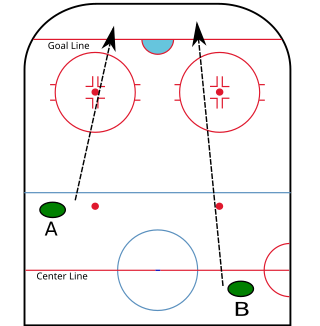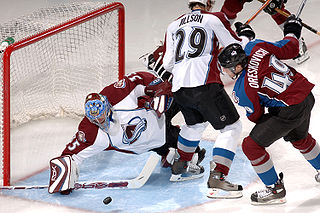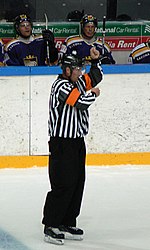
Ice hockey is a team sport played on ice skates, usually on an ice skating rink with lines and markings specific to the sport. It belongs to a family of sports called hockey. In ice hockey, two opposing teams use ice hockey sticks to control, advance, and shoot a closed, vulcanized, rubber disc called a "puck" into the other team's goal. Each goal is worth one point. The team which scores the most goals is declared the winner. In a formal game, each team has six skaters on the ice at a time, barring any penalties, one of whom is the goaltender. Ice hockey is a full contact sport, and is considered to be one of the more physically demanding team sports.
"Power play" is a sporting term used to describe a period of play where one team has a numerical advantage in players, usually due to a rule violation by the opposing team.

Box lacrosse, also known as boxla, box, or indoor lacrosse, is an indoor version of lacrosse played mostly in North America. The game originated in Canada in the 1930s, where it is more popular than field lacrosse. Lacrosse is Canada's official national summer sport. Box lacrosse is played between two teams of five players and one goalie each, and is traditionally played on an ice hockey rink once the ice has been removed or covered. The playing area is called a box, in contrast to the open playing field of field lacrosse. The object of the game is to use a lacrosse stick to catch, carry, and pass the ball in an effort to score by shooting a solid rubber lacrosse ball into the opponent's goal. The highest level of box lacrosse is the National Lacrosse League.

In ice hockey, icing is an infraction when a player shoots, bats with the hand or stick or deflects the puck over the center red line and the opposing team's red goal line, in that order, and the puck remains untouched without scoring a goal. The rule's main purpose is preventing a defending team from delaying the game by, relatively easily, sending the puck to the other side of the rink.

In ice hockey, the goaltender is the player responsible for preventing the hockey puck from entering their team's net, thus preventing the opposing team from scoring. The goaltender mostly plays in or near the area in front of the net called the goal crease. Goaltenders tend to stay at or beyond the top of the crease to cut down on the angle of shots. In the modern age of goaltending there are two common styles, butterfly and hybrid. Because of the power of shots, the goaltender wears special equipment to protect the body from direct impact.

A penalty in ice hockey is a punishment for an infringement of the rules. Most penalties are enforced by sending the offending player to a penalty box for a set number of minutes. During the penalty the player may not participate in play. Penalties are called and enforced by the referee, or in some cases, the linesman. The offending team may not replace the player on the ice, leaving them short-handed as opposed to full strength. When the opposing team is said to be on a power play, they will have one more player on the ice than the short-handed team. The short-handed team is said to be "on the penalty kill" until the penalty expires and the penalized player returns to play. While standards vary somewhat between leagues, most leagues recognize several common varieties of penalties, as well as common infractions.
Checking in ice hockey is any of a number of defensive techniques aimed at disrupting an opponent with possession of the puck or separating him from the puck entirely. Most types are not subject to penalty.
In ice hockey, a penalty shot is a type of penalty awarded when a team loses a clear scoring opportunity on a breakaway because of a foul committed by an opposing player. A player from the non-offending team is given an attempt to score a goal without opposition from any defending players except the goaltender. This is the same type of shot used in a shootout to decide games in some leagues.

Floor hockey is a broad term for several indoor floor game codes which involve two teams using a stick and type of ball or disk. Disks are either open or closed but both designs are usually referred to as "pucks". These games are played either on foot or with wheeled skates. Variants typically reflect the style of ice hockey, field hockey, bandy or some other combination of sport. Games are commonly known by various names including cosom hockey, ball hockey, floorball, or simply floor hockey.
In ice hockey, a play is offside if a player on the attacking team enters the offensive zone before the puck itself does, and then receives possession of the puck from the neutral zone. Simply put, the puck must not enter the attacking zone after attacking players. If a player on the attacking team is in the offensive zone before the puck, either an immediate offside occurs, or they must retreat to the neutral zone.

In ice hockey, an official is a person who has some responsibility for enforcing the rules and maintaining the order of the game. There are two categories of officials, on-ice officials, who are the referees and linesmen that enforce the rules during gameplay, and off-ice officials, who have an administrative role rather than an enforcement role.

Roller inline hockey, or inline hockey is a variant of hockey played on a hard, smooth surface, with players using inline skates to move and ice hockey sticks to shoot a hard, plastic puck into their opponent's goal to score points. The sport is a very fast-paced and free-flowing game and is considered a contact sport, but body checking is prohibited. There are five players including the goalkeeper from each team on the rink at a time, while teams normally consist of 16 players. There are professional leagues, one of which is the National Roller Hockey League (NRHL). While it is not a contact sport, there are exceptions, i.e. the NRHL involves fighting.

In sports, an ejection is the removal of a participant from a contest due to a violation of the sport's rules. The exact violations that lead to an ejection vary depending upon the sport, but common causes for ejection include unsportsmanlike conduct, violent acts against another participant that are beyond the sport's generally accepted standards for such acts, abuse against officials, violations of the sport's rules that the contest official deems to be egregious, or the use of an illegal substance to better a player's game. Most sports have provisions that allow players to be ejected, and many allow for the ejection of coaches, managers, or other non-playing personnel. In sports that use penalty cards, a red card is often used to signal dismissals.

High-sticking is the name of two infractions in the sport of ice hockey. It is also the name of a minor penalty called in the sport of ringette. This article deals chiefly with situations involving the sport of ice hockey.

The National Hockey League rules are the rules governing the play of the National Hockey League (NHL), a professional ice hockey organization. Infractions of the rules, such as offside and icing, lead to a stoppage of play and subsequent to the offending teams. The league also determines the specifications for playing equipment used in its games.
Too many men is a penalty that may be called in various team sports when the team has more players on the field or other playing area than are allowed by the rules. Penalties vary from one sport to the next.
This is a list of common terms used in the sport of ice hockey along with the definitions of these terms.
No goal is a call made by referees in various goal-scoring sports to indicate that a goal has not been scored. It is commonly used to disallow an apparent goal, such as when the ball or puck has entered the net but should not count as a score due to some foul or infraction.
Cross-checking is an infraction in the sports of ice hockey and ringette where a player checks an opponent by using the shaft of their ice hockey stick or ringette stick with both hands. This article deals chiefly with ice hockey.
In ice hockey, an awarded goal is an unusual situation in which a goal is awarded to a team rather than scored. A penalty shot is a type of penalty awarded when a team loses a clear scoring opportunity on a breakaway because of a foul committed by an opposing player. A player from the non-offending team is given an attempt to score a goal without opposition from any defending players except the goaltender. However, when such a lost opportunity occurs and the opposing team has pulled its goalie to allow for an extra attacker, a goal is simply awarded without a penalty shot taking place.












